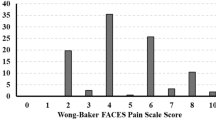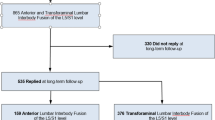Abstract
Background
There is significant debate regarding the indications of staged surgery for severe adolescent spinal deformity, and the factors associated with the decision to perform staged compared to same-day surgery have not been previously investigated. Thus, the purpose of this study was to determine which factors were most strongly associated with this decision.
Methods
A prospective multicenter registry of adolescent patients with severe spinal deformity was reviewed. Two cohorts were identified: those who underwent a planned staged surgical procedure for deformity correction and those who underwent a same-day procedure. Patients who underwent an unplanned staged procedure secondary to complications during the initial procedure were excluded. Comparisons were made between these cohorts with respect to preoperative patient and radiographic variables to determine which factors were associated with the decision to perform a staged procedure. Surgical data was also compared to evaluate for differences in the intraoperative management of staged versus same-day patients.
Results
Two hundred and twenty-nine patients with severe spinal deformities were identified. Forty patients (17%) underwent a planned staged procedure and 189 patients (80%) underwent a same-day procedure. On univariate analysis of preoperative variables, patients who underwent staged surgery had a significantly younger age at surgery, greater major curve magnitude, greater major curve AVT to CSVL, lesser thoracic spine height, greater radiographic trunk shift, and a greater proportion of patients undergoing revision surgery (as opposed to primary correction) compared to those who underwent a planned single-stage procedure. Multivariate logistic regression of pre-operative variables showed that age < 16 years, maximum cobb angle ≥ 120 degrees, major curve AVT to CSVL of ≥ 3.5 cm, and revision surgery were independently associated with the decision to perform a staged procedure. Intraoperatively, patients in the staged cohort more frequently underwent combined anterior and posterior procedures, grade 4 or higher Schwab osteotomies, and had a greater number of levels fused.
Conclusion
There is substantial variability with respect to the decision to perform surgery for severe adolescent spine deformities in a staged versus same-day fashion. This large analysis of prospectively collected data is the first to describe the factors most strongly associated with the decision to perform a staged procedure and may help guide the surgical decision-making for these patients.



Similar content being viewed by others
References
Neal KM, Siegall E (2017) Strategies for surgical management of large, stiff spinal deformities in children. J Am Acad Orthop Surg. https://doi.org/10.5435/JAAOS-D-16-00282
Boachie-Adjei O, Yagi M, Nemani VM et al (2015) Incidence and risk factors for major surgical complications in patients with complex spinal deformity: a report from an SRS GOP site. Spine Deform. https://doi.org/10.1016/j.jspd.2014.06.008
Lenke LG, Newton PO, Sucato DJ et al (2013) Complications after 147 consecutive vertebral column resections for severe pediatric spinal deformity: a multicenter analysis. Spine 38:119. https://doi.org/10.1097/BRS.0b013e318269fab1
Master DL, Son-Hing JP, Poe-Kochert C et al (2011) Risk factors for major complications after surgery for neuromuscular scoliosis. Spine. https://doi.org/10.1097/BRS.0b013e3181e193e9
Il SS, Kim JH, Cho KJ et al (2007) Is anterior release necessary in severe scoliosis treated by posterior segmental pedicle screw fixation? Eur Spine J. https://doi.org/10.1007/s00586-007-0334-x
Luhmann SJ, Lenke LG, Kim YJ et al (2005) Thoracic adolescent idiopathic scoliosis curves between 70° and 100°: is anterior release necessary? Spine. https://doi.org/10.1097/01.brs.0000179299.78791.96
Powell ET, Krengel WF, King HA et al (1994) Comparison of same-day sequential anterior and posterior spinal fusion with delayed two-stage anterior and posterior spinal fusion. Spine. https://doi.org/10.1097/00007632-199405310-00011
Shufflebarger HL, Grimm JO, Bui V et al (1991) Anterior and posterior spinal fusion: staged versus same-day surgery. Spine. https://doi.org/10.1097/00007632-199108000-00011
Ferguson RL, Hansen MM, Nicholas DA et al (1996) Same-day versus staged anterior-posterior spinal surgery in a neuromuscular scoliosis population: the evaluation of medical complications. J Pediatr Orthop. https://doi.org/10.1097/01241398-199605000-00003
O’Brien T, Akmakjian J, Ogin G, Eilert R et al (1992) Comparison of one-stage versus two-stage anterior/posterior spinal fusion for neuromuscular scoliosis. J Pediatr Orthop. https://doi.org/10.1097/01241398-199209000-00009
Shen J, Qiu G, Wang Y et al (2006) Comparison of 1-stage versus 2-stage anterior and posterior spinal fusion for severe and rigid idiopathic scoliosis-a randomized prospective study. Spine. https://doi.org/10.1097/01.brs.0000240704.42264.c4
Tsirikos AI, Chang WN, Dabney KW et al (2003) Comparison of one-stage versus two-stage anteroposterior spinal fusion in pediatric patients with cerebral palsy and neuromuscular scoliosis. Spine. https://doi.org/10.1097/00007632-200306150-00015
Hopf CG, Eysel P (2000) One-stage versus two-stage spinal fusion in neuromuscular scolioses. J Pediatr Orthop Part B. https://doi.org/10.1097/01202412-200010000-00005
McDonnell MF, Classman SD, Dimar JR et al (1996) Perioperative complications of anterior procedures on the spine. J Bone Jt Surg-Ser A. https://doi.org/10.2106/00004623-199606000-00006
Gum JL, Lenke LG, Bumpass D et al (2016) Does planned staging for posterior-only vertebral column resections in spinal deformity surgery increase perioperative complications? Spine Deform. https://doi.org/10.1016/j.jspd.2015.08.005
Passias PG, Ma Y, Chiu YL et al (2012) Comparative safety of simultaneous and staged anterior and posterior spinal surgery. Spine. https://doi.org/10.1097/BRS.0b013e31821350d0
Jackson T, Yaszay B, Sponseller PD et al (2019) Factors associated with surgical approach and outcomes in cerebral palsy scoliosis. Eur Spine J. https://doi.org/10.1007/s00586-018-5745-3
Acknowledgements
The Fox Study Group.
Funding
The authors received no funding for the preparation of this manuscript.
Author information
Authors and Affiliations
Consortia
Contributions
SMLV: Writing—original draft preparation; Formal analysis and investigation; Methodology; Writing—review and editing; Critical revision; Accountability; Final approval. IS: Conceptualization; Data Acquisition; Formal analysis and investigation; Writing—review and editing; Accountability; Final approval. SG. Conceptualization; Data Acquisition; Writing—review and editing; Critical revision; Accountability; Final approval. BY: Conceptualization; Data Acquisition; Critical revision; Accountability; Supervision; Final approval. MCG: Conceptualization; Data Acquisition; Writing—review and editing; Critical revision; Supervision; Accountability; Final approval. DJS: Conceptualization; Data Acquisition; Critical revision; Supervision; Accountability; Final approval. MPK: Conceptualization; Data Acquisition; Writing—review and editing; Critical revision; Supervision; Accountability; Final approval. AS: Conceptualization; Data Acquisition; Writing—review and editing; Critical revision; Supervision; Final approval. LL: Conceptualization; Data Acquisition; Critical revision; Supervision; Final approval. OB: Conceptualization; Data Acquisition; Critical revision; Supervision; Final approval. The Fox Study Group: Data Acquisition; Supervision; Accountability; Final approval. PJC: Conceptualization; Data Acquisition; Writing—review and editing; Critical revision; Supervision; Accountability; Final approval.
Corresponding author
Ethics declarations
Conflict of interest
The authors of this work have no disclosures related to this study.
Ethical approval
This study was given Ethical Approval by the Institutional Review Board prior to the conduct of this study.
Informed consent
Informed consent was obtained.
Additional information
Publisher's Note
Springer Nature remains neutral with regard to jurisdictional claims in published maps and institutional affiliations.
Rights and permissions
Springer Nature or its licensor (e.g. a society or other partner) holds exclusive rights to this article under a publishing agreement with the author(s) or other rightsholder(s); author self-archiving of the accepted manuscript version of this article is solely governed by the terms of such publishing agreement and applicable law.
About this article
Cite this article
LaValva, S.M., Swarup, I., Garg, S. et al. Who gets staged surgery in severe pediatric and adolescent spine deformity?. Spine Deform 12, 383–390 (2024). https://doi.org/10.1007/s43390-023-00778-8
Received:
Accepted:
Published:
Issue Date:
DOI: https://doi.org/10.1007/s43390-023-00778-8




